Sedum Clavatum Succulent Grow & Care Guide
Written by Iris
Sep 23 2021
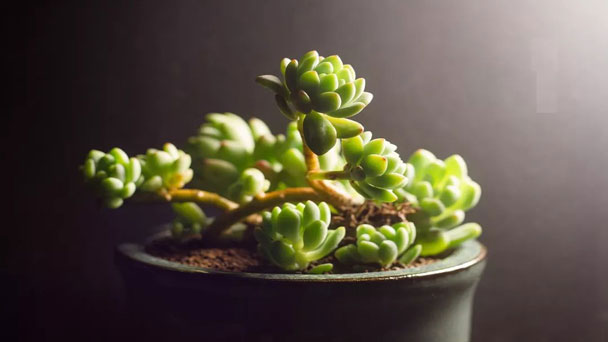
Sedum Clavatum (Tiscalatengo Gorge Sedum) is a succulent plant in the Crassulaceae family. It is a perennial herbaceous plant originally grown in Mexico. Because of its beautiful appearance and aromatic taste, Sedum Clavatum has been introduced to various parts of the world. The leaves of Sedum Clavatum are plump, tender green or emerald green, and the leaves are covered with a thin layer of white powder. In the environment with sufficient sunlight or relatively large temperature differences, the tip of the leaf will still have a beautiful red color. At some point, the color of the leaves will turn into yellow-green or light green like jelly. It looks frozen and transparent and can be broken by blowing. In spring, beautiful white flowers will appear with pink stamens.
Sedum clavatum is a plant that requires up to 6 hours of sun when planted inside keep it on a window ledge. That means a south-facing window for most of us.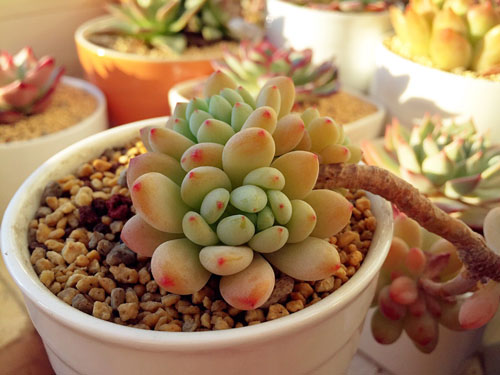
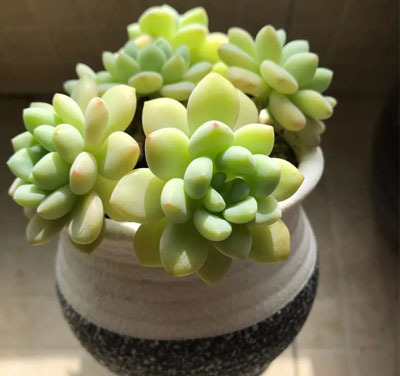
To propagate sedum clavatum with branch cutting technique, ensure the branch you choose is not infested by pest. Also, ensure it is a fully grown branch with well-developed leaves.
The next step is to remove the leaves and stick the branch in damp soil. After about two to three weeks, you can water the soil. Once you notice the roots are about too long, move the plant to a new pot and water them as recommended above.
Allow the leaf to callous over for several days, and then lay on well-draining soil. Water whenever the soil has dried completely. After roots and a rosette have appeared, and the mother leaf has withered away, plant the new growth.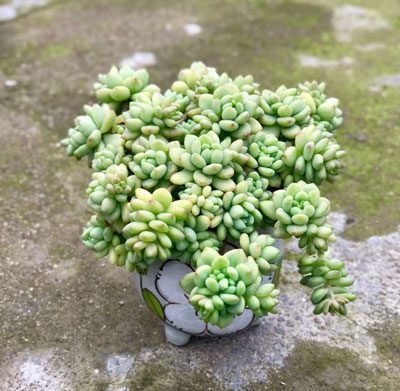
Tiscalatengo Gorge Sedum is best planted in an area that receives at least 6 hours of sunlight. This succulent can also be used as a hanging plant where its leaves can be allowed to extend and trail further.
Use only potting mix or cacti/succulent friendly mixes when planting your sedums in containers.
The succulents will rot if you put them into garden soil because it cannot drain quickly enough to prevent the water from suffocating the plant roots.
The Sedum clavatum is a succulent, so it needs soil that remains moist but does not become waterlogged.
Be very careful that you don't overwater your sedum clavatum succulent. If you overwater this succulent then there’s a very high chance that root rot will appear. As we have mentioned, root rot is the #1 most common reason why your succulent will die.
Overwatering/root rot symptoms would be mushy leaves, rotting, molding, and look like it's dying. All this is happening simply because you have overwatered your sedum clavatum succulent.
Like most succulents, the sedum clavatum succulent doesn't need or want too much water. This is why watering this succulent once a week and once a week only is the perfect amount of water for growing this succulent healthy.
Be on the lookout for underwatering symptoms as well, those symptoms would be dry/wrinkled leaves. If your succulent has dry/wrinkled leaves then definitely water it asap.
You should also keep track of the exact last time you watered your succulent. If a watering issue does occur then you will know exactly what's going on and how to treat it immediately. You must take action immediately and treat/save your succulent.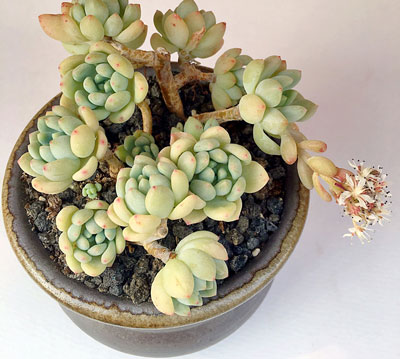
The Sedum clavatum succulent plant thrives best in temperatures that range between 65°F (18°C) and 75°F (25°C), and ann ideal level of humidity for this plant is around 50%.
Temperature and humidity are important for Sedum to thrive, as they tend to be susceptible to root rot.
Ensure that the sedums are not placed in cold temperatures or areas with high levels of moisture (i.e., under dripping faucets).
Sedum clavatum succulents are susceptible to root rot, so they need to be trimmed on occasion.
You can trim sedums in two ways:
It's a good idea to trim off any long or leggy stems that are sticking out and causing the Sedum clavatum to spread too thin across your garden bed, giving it an unkempt appearance.
Where to Grow Sedum ClavatumWhen to Grow Sedum ClavatumHow to Grow Sedum Clavatum Grow Sedum Clavatum from SeedsGrow Sedum Clavatum from Branch CuttingsGrow Sedum Clavatum from Leaf CuttingsSedum Clavatum CareSedum Clavatum Light RequirementSedum Clavatum Soil CareSedum Clavatum WateringSedum Clavatum Temperature & Humidity CareSedum Clavatum FertilizerSedum Clavatum PruningSedum Clavatum Pests & Diseases CareSedum Clavatum FAQIs Sedum Clavatum toxic?Is Sedum Clavatum invasive?Why is my Sedum Clavatum Succulent Dying?Does the Sedum Clavatum Produce Flowers?
Where to Grow Sedum Clavatum
Sedum clavatum is a plant that grows easiest in free-draining gritty compost. The plant does not handle cold well, so if you live an area that is colder than – 1,1°C (30°F) use a succulent container. It makes it easier to transport the plant indoor and outdoor.Sedum clavatum is a plant that requires up to 6 hours of sun when planted inside keep it on a window ledge. That means a south-facing window for most of us.

When to Grow Sedum Clavatum
Sedum clavatum actively grows in cooler months. It's best to fertilize during the Spring and Fall, and avoid fertilizing in the summer.
How to Grow Sedum Clavatum
Grow Sedum Clavatum from Seeds
If propagating from seed, sow in a well-draining soil in the fall. You can grow sedum clavatum seeds outdoors if you live in an zone above 9a. If you live in a cooler area, you can begin sowing indoors under a grow light.Grow Sedum Clavatum from Branch Cuttings
This method of propagating sedum clavatum is faster and more effective than the leaf insertion method.To propagate sedum clavatum with branch cutting technique, ensure the branch you choose is not infested by pest. Also, ensure it is a fully grown branch with well-developed leaves.
The next step is to remove the leaves and stick the branch in damp soil. After about two to three weeks, you can water the soil. Once you notice the roots are about too long, move the plant to a new pot and water them as recommended above.
Grow Sedum Clavatum from Leaf Cuttings
Learning how to propagate Sedum clavatum, begin by selecting a sturdy, healthy leaf. You can easily propagate the leaves of Sedums by choosing a firm, healthy leaf. Remove it from the main plant by gently twisting the leaf from the stem. Be sure not to leave any of the leaf on the stem (if you take a bit of the stem with the leaf, that's fine, too!).Allow the leaf to callous over for several days, and then lay on well-draining soil. Water whenever the soil has dried completely. After roots and a rosette have appeared, and the mother leaf has withered away, plant the new growth.

Sedum Clavatum Care
Sedum Clavatum Light Requirement
Sedum Clavatum is best grown outdoors where exposure to sunlight can transform its blue-green leaves into a mesmerizing light pink. If the succulent is grown indoors, the leaves will not produce bright colors.Tiscalatengo Gorge Sedum is best planted in an area that receives at least 6 hours of sunlight. This succulent can also be used as a hanging plant where its leaves can be allowed to extend and trail further.
Sedum Clavatum Soil Care
The Sedum clavatum prefers a soil that is well-drained and evenly moist.Use only potting mix or cacti/succulent friendly mixes when planting your sedums in containers.
The succulents will rot if you put them into garden soil because it cannot drain quickly enough to prevent the water from suffocating the plant roots.
The Sedum clavatum is a succulent, so it needs soil that remains moist but does not become waterlogged.
Sedum Clavatum Watering
You should water your sedum clavatum succulent once a week and once a week only. This is the perfect amount of watering for growing healthy sedum clavatum succulents.Be very careful that you don't overwater your sedum clavatum succulent. If you overwater this succulent then there’s a very high chance that root rot will appear. As we have mentioned, root rot is the #1 most common reason why your succulent will die.
Overwatering/root rot symptoms would be mushy leaves, rotting, molding, and look like it's dying. All this is happening simply because you have overwatered your sedum clavatum succulent.
Like most succulents, the sedum clavatum succulent doesn't need or want too much water. This is why watering this succulent once a week and once a week only is the perfect amount of water for growing this succulent healthy.
Be on the lookout for underwatering symptoms as well, those symptoms would be dry/wrinkled leaves. If your succulent has dry/wrinkled leaves then definitely water it asap.
You should also keep track of the exact last time you watered your succulent. If a watering issue does occur then you will know exactly what's going on and how to treat it immediately. You must take action immediately and treat/save your succulent.

Sedum Clavatum Temperature & Humidity Care
In general, sedums are suitable for hot and dry environments with low humidity.The Sedum clavatum succulent plant thrives best in temperatures that range between 65°F (18°C) and 75°F (25°C), and ann ideal level of humidity for this plant is around 50%.
Temperature and humidity are important for Sedum to thrive, as they tend to be susceptible to root rot.
Ensure that the sedums are not placed in cold temperatures or areas with high levels of moisture (i.e., under dripping faucets).
Sedum Clavatum Fertilizer
It is best to use a slow-release or time-released granular organic plant food. These are perfect for Sedum Clavatum because they will feed the plants over an extended period. Generally, it's important not to fertilize sedums too frequently because doing so can contribute to succulent rot and root death. Fertilizing this succulent during the spring and fall yields the best results.Sedum Clavatum Pruning
Pruning sedums is a crucial part of maintaining the plants.Sedum clavatum succulents are susceptible to root rot, so they need to be trimmed on occasion.
You can trim sedums in two ways:
- Use your shears or pruning stick and cut off any dead leaves at their base near the ground
- Pinch back new growth with your fingers when they’re smaller than three inches tall.
It's a good idea to trim off any long or leggy stems that are sticking out and causing the Sedum clavatum to spread too thin across your garden bed, giving it an unkempt appearance.
Sedum Clavatum Pests & Diseases Care
Sedum Clavatum plants are called stonecrop because they are tough and rugged. They succumb to very few diseases or pest problems as long as they receive ample sun and the right amount of water. Overwatering will naturally cause problems with fungal infection. Weakened plants are susceptible to infestation by succulent aphids and scale insects.'
Sedum Clavatum FAQ
Is Sedum Clavatum toxic?
All sedum are non-toxic.Is Sedum Clavatum invasive?
Under ideal conditions, sedum of all sorts spread enthusiastically, but they are not considered invasive. If your sedum does reproduce more than you would like, simply lift a bunch and place it elsewhere.Why is my Sedum Clavatum Succulent Dying?
Your Sedum Clavatum succulent could be dying because of these 3 reasons:- Underwatering
- Overwatering
- Infestation
Does the Sedum Clavatum Produce Flowers?
Sedum Clavatum can produce multiple small, white, star-shaped flowers from mid to late spring until early summer.Latest Updated
- Benefits of Bugleweed - 7 Science-backed Health Benefits
- Bugleweed Dangers & Side Effects - Is It Poisonous?
- How to Plant Evergreen Trees - What You Should Know
- When to Plant Evergreens - Grow Guide for Evergreen Trees
- 12 Wonderful Evergreen Shrubs for Your Garden
- 12 Popular Evergreen Plants with Pictures for Beginners
- When And How To Prune A Lilac Bush Like a Pro
- How to Grow & Care for Lilac Vine (Hardenbergia Violacea)
- Japanese Lilac Tree (Syringa Reticulata) Care & Propagation Guide
- Shumard Oak Pros and Cons - What to Know
Popular Articles
- Winter maintenance of Antirrhinum Majus
- How to Grow Terminalia Mantaly Tree
- How to Grow and Care for Crossostephium Chinense
- How to grow Antirrhinum Majus in spring
- Peristeria Elata (Dove Orchid) Profile: Info & Care Guide
- Underwatered Snake Plant (Sansevieria Trifasciata) - Signs And How To Fix
- How to Care for Brazilian Jasmine Plant (Mandevilla Sanderi)
- How to Grow & Care for Graptopetalum Purple Delight in Summer
- Rosa Chinensis (China Rose): Plant Growing & Care Tips
- How to Care for Baby Sun Rose (Aptenia Cordifolia)